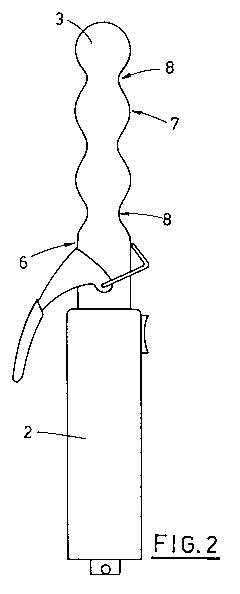Some of the information on this Web page has been provided by external sources. The Government of Canada is not responsible for the accuracy, reliability or currency of the information supplied by external sources. Users wishing to rely upon this information should consult directly with the source of the information. Content provided by external sources is not subject to official languages, privacy and accessibility requirements.
Any discrepancies in the text and image of the Claims and Abstract are due to differing posting times. Text of the Claims and Abstract are posted:
| (12) Patent Application: | (11) CA 2737501 |
|---|---|
| (54) English Title: | A HAIR CURLING DEVICE |
| (54) French Title: | DISPOSITIF POUR FRISER LES CHEVEUX |
| Status: | Deemed Abandoned and Beyond the Period of Reinstatement - Pending Response to Notice of Disregarded Communication |
| (51) International Patent Classification (IPC): |
|
|---|---|
| (72) Inventors : |
|
| (73) Owners : |
|
| (71) Applicants : |
|
| (74) Agent: | MARKS & CLERK |
| (74) Associate agent: | |
| (45) Issued: | |
| (86) PCT Filing Date: | 2009-05-15 |
| (87) Open to Public Inspection: | 2010-03-25 |
| Availability of licence: | N/A |
| Dedicated to the Public: | N/A |
| (25) Language of filing: | English |
| Patent Cooperation Treaty (PCT): | Yes |
|---|---|
| (86) PCT Filing Number: | PCT/EP2009/055919 |
| (87) International Publication Number: | WO 2010031603 |
| (85) National Entry: | 2011-03-16 |
| (30) Application Priority Data: | ||||||
|---|---|---|---|---|---|---|
|
A hair-curling device, of a type comprising a grip (2) for supporting a
shaped body (3) having an elongate shape on which a lock of hair is rolled,
and electrical
heating means (4) associated to the shaped body (3) for defining a
predetermined
curl in the lock of hair wound on the body (3), the grip (2) fixedly
supporting the shaped
body (3); the body (3) being symmetrically shaped with respect to relative
median horizontal
and vertical planes thereof and longitudinally exhibiting a transversal
section
which varies continuously from a minimum value to a maximum value, and vice
versa,
according to a predetermined progression.
L'invention porte sur un dispositif pour friser les cheveux, d'un type comprenant un élément de préhension (2) pour supporter un corps ayant une certaine forme (3), ayant une forme allongée, sur lequel une mèche de cheveux est enroulée, et des moyens de chauffage électrique (4) associés au corps ayant une certaine forme (3) pour définir un bouclage prédéterminé dans la mèche de cheveux enroulée sur le corps (3), l'élément de préhension (2) supportant de façon fixe le corps ayant une certaine forme (3); le corps (3) est conformé de façon symétrique vis-à-vis des plans médians horizontal et vertical relatifs de celui-ci, et présente longitudinalement une section transversale qui varie de façon continue d'une valeur minimale à une valeur maximale, et inversement, selon une progression prédéterminée.
Note: Claims are shown in the official language in which they were submitted.
Note: Descriptions are shown in the official language in which they were submitted.

2024-08-01:As part of the Next Generation Patents (NGP) transition, the Canadian Patents Database (CPD) now contains a more detailed Event History, which replicates the Event Log of our new back-office solution.
Please note that "Inactive:" events refers to events no longer in use in our new back-office solution.
For a clearer understanding of the status of the application/patent presented on this page, the site Disclaimer , as well as the definitions for Patent , Event History , Maintenance Fee and Payment History should be consulted.
| Description | Date |
|---|---|
| Application Not Reinstated by Deadline | 2015-05-15 |
| Time Limit for Reversal Expired | 2015-05-15 |
| Inactive: Abandon-RFE+Late fee unpaid-Correspondence sent | 2014-05-15 |
| Deemed Abandoned - Failure to Respond to Maintenance Fee Notice | 2014-05-15 |
| Inactive: Cover page published | 2011-05-18 |
| Inactive: Inventor deleted | 2011-05-04 |
| Inactive: Notice - National entry - No RFE | 2011-05-04 |
| Inactive: IPC assigned | 2011-05-04 |
| Application Received - PCT | 2011-05-04 |
| Inactive: First IPC assigned | 2011-05-04 |
| Inactive: IPC assigned | 2011-05-04 |
| Inactive: IPC assigned | 2011-05-04 |
| Small Entity Declaration Determined Compliant | 2011-03-16 |
| National Entry Requirements Determined Compliant | 2011-03-16 |
| Application Published (Open to Public Inspection) | 2010-03-25 |
| Abandonment Date | Reason | Reinstatement Date |
|---|---|---|
| 2014-05-15 |
The last payment was received on 2013-05-08
Note : If the full payment has not been received on or before the date indicated, a further fee may be required which may be one of the following
Please refer to the CIPO Patent Fees web page to see all current fee amounts.
| Fee Type | Anniversary Year | Due Date | Paid Date |
|---|---|---|---|
| MF (application, 2nd anniv.) - small | 02 | 2011-05-16 | 2011-03-16 |
| Basic national fee - small | 2011-03-16 | ||
| MF (application, 3rd anniv.) - small | 03 | 2012-05-15 | 2012-05-04 |
| MF (application, 4th anniv.) - small | 04 | 2013-05-15 | 2013-05-08 |
Note: Records showing the ownership history in alphabetical order.
| Current Owners on Record |
|---|
| MAURO CATINI |
| Past Owners on Record |
|---|
| None |